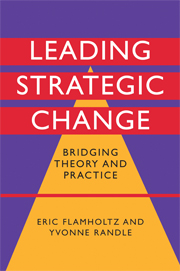Book contents
- Frontmatter
- Contents
- List of exhibits
- Preface
- Acknowledgments
- Part I An integrative framework for leading strategic and organizational change
- Part II Leading strategic change in actual organizations
- Part III Leading strategic change: lessons learned from practice
- Appendix: References for further reading on leading change
- Index
Part II - Leading strategic change in actual organizations
Published online by Cambridge University Press: 22 September 2009
- Frontmatter
- Contents
- List of exhibits
- Preface
- Acknowledgments
- Part I An integrative framework for leading strategic and organizational change
- Part II Leading strategic change in actual organizations
- Part III Leading strategic change: lessons learned from practice
- Appendix: References for further reading on leading change
- Index
Summary
Part I of this book presented a framework for understanding and managing strategic and organizational change. It described the theory underlying the change management process and tools that can be used by leaders of change in applying these concepts in practice within their organizations. It also presented a framework and approach for planning for and managing the phases of change, and identified the capabilities that those in leadership positions need to possess to lead the change process successfully.
Part II consists of nine chapters, each presenting a case study of a company that successfully managed change. Some of these companies – Starbucks (chapter 5) and Westfield (chapter 12) – are global enterprises. Others are well known in their country of origin – Countrywide Financial Corporation (chapter 4), Indian Oil (chapter 6), and Tata Steel (chapter 11). Still others are known within their specific geographic area or industry – Stan Tashman and Associates (chapter 7), IndyMac Bank (chapter 8), Infogix (chapter 9), and Pardee Homes (chapter 10). What all these companies have in common, however, is that their leadership teams planned for and successfully managed strategic organizational change.
The types of changes that were the primary focus for management at each company range from changing or creating an entirely new business “concept” (Countrywide Financial Corporation, Starbucks, Tashman, IndyMac Bank, Infogix, Westfield), to changing the company's structure (Pardee Homes), to changing the company's culture (Indian Oil Corporation, Tata Steel).
- Type
- Chapter
- Information
- Leading Strategic ChangeBridging Theory and Practice, pp. 67 - 68Publisher: Cambridge University PressPrint publication year: 2008



